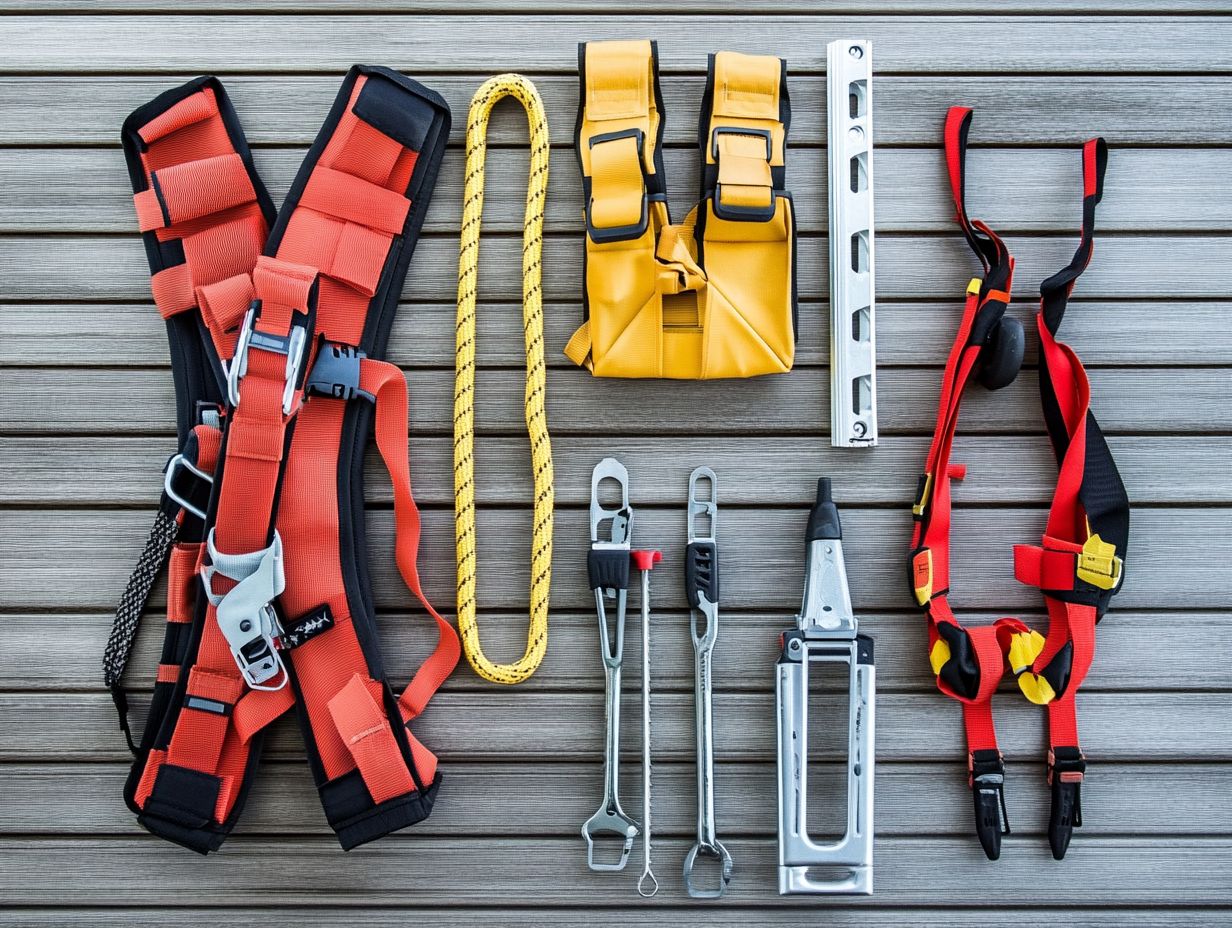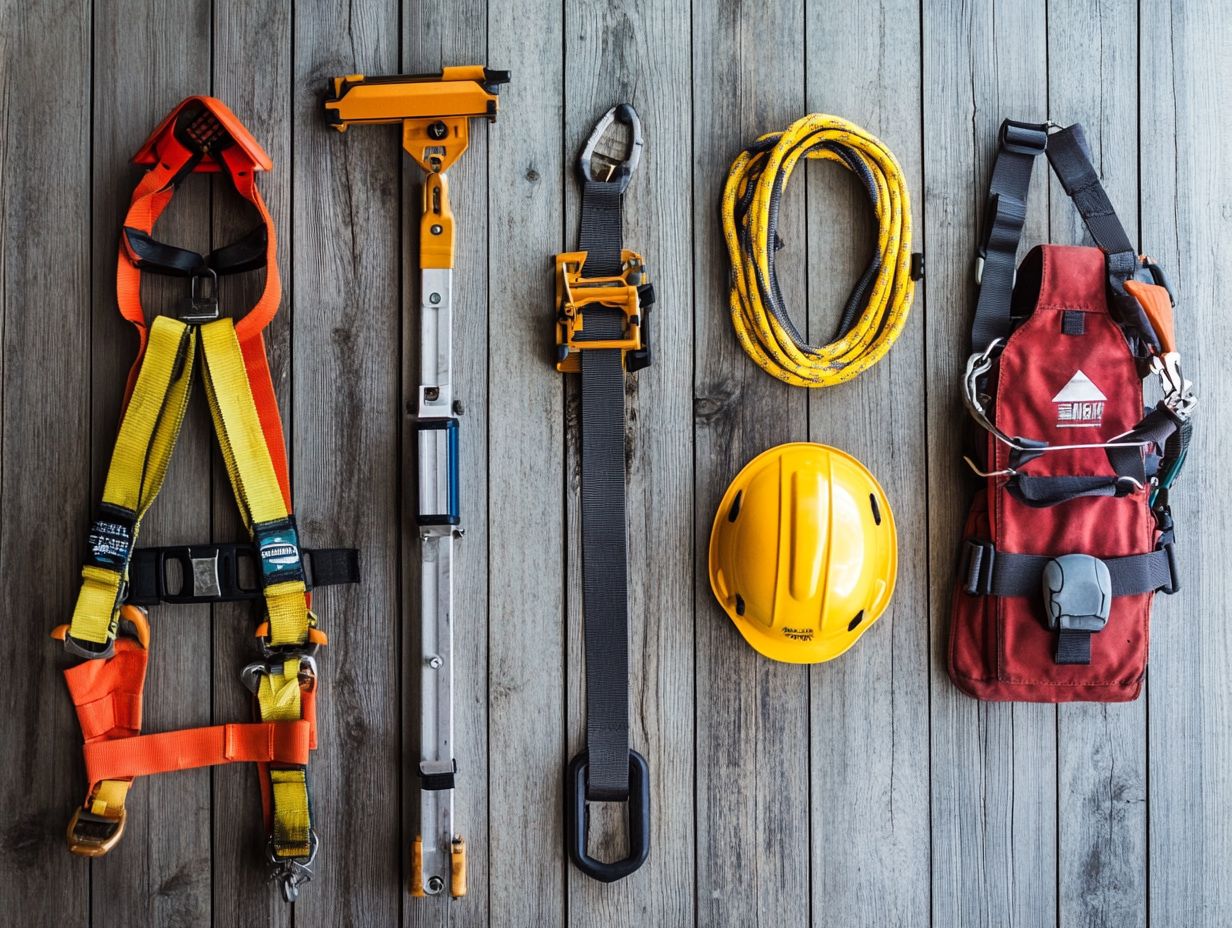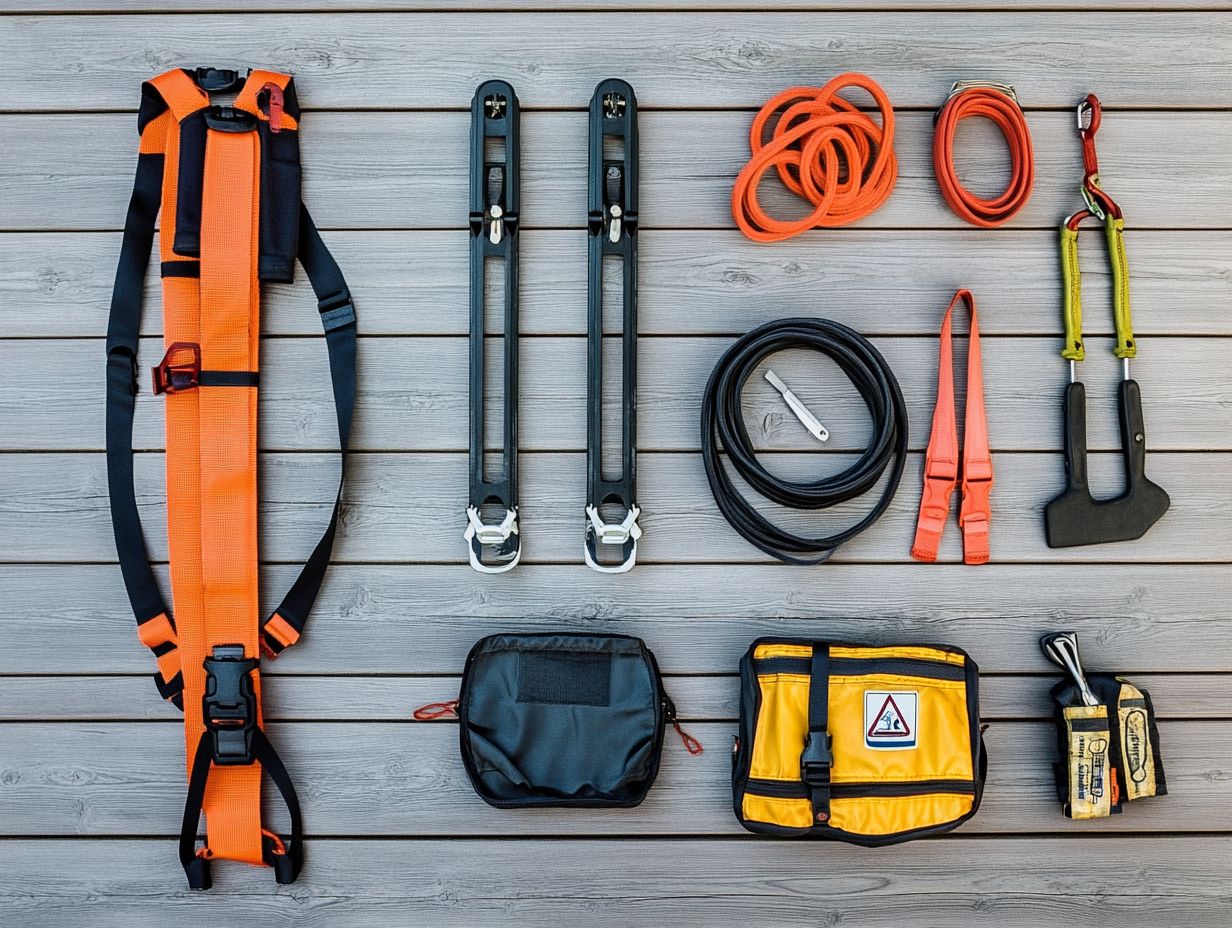Working at heights always comes with risks, but using the right ladder safety devices can greatly reduce the chances of an accident.
In this article, we’ll explore five innovative ladder safety devices that every homeowner should consider to make ladder use safer and more secure.
From locking stabilizers to anti-slip feet, each device offers unique features designed to enhance stability and confidence while you work. By understanding how these tools can transform your approach to home projects, you’ll gain greater peace of mind every time you climb.
The Importance of Using Ladder Safety Devices

The importance of utilizing ladder safety devices is paramount, particularly for homeowners involved in DIY projects and home improvement activities. Ensuring safety while working at heights is critical to preventing ladder-related injuries, which can result in severe consequences.
By employing innovative safety devices and adhering to established ladder safety guidelines, homeowners can significantly mitigate the risk of falls and enhance their overall safety during ladder use. Furthermore, awareness of ladder safety standards and the importance of proper equipment maintenance are essential components in creating a secure working environment when using extension ladders or portable ladders.
A variety of ladder safety devices, including stabilizers, ladder levelers, and harnesses, are specifically designed to enhance user protection while providing stability and support. These devices not only facilitate compliance with safety regulations but also instill confidence in homeowners as they undertake their projects.
Given that statistics indicate nearly 300,000 injuries occur each year due to ladder accidents, the necessity for effective ladder safety equipment becomes increasingly evident.
Regular inspection of ladders is critical, as worn or damaged equipment can lead to catastrophic failures. Additionally, proper safety training can convert a potentially hazardous situation into a manageable one, ensuring that each home improvement project is completed without incident.
Innovative Ladder Safety Devices
In the field of ladder safety, innovative products have emerged as essential tools aimed at enhancing safety and stability for both homeowners and professionals. These advanced ladder safety devices not only improve user experience but also ensure compliance with safety regulations, rendering them essential for individuals utilizing adjustable or multi-position ladders.
By integrating cutting-edge technology and ergonomic design, these devices have transformed the approach to home improvement tasks, significantly mitigating the risk of falls and accidents.
Overview of 5 Must-Have Devices
In the realm of ladder safety, there are five essential devices that every homeowner should consider incorporating into their toolkit to promote safe climbing practices and minimize the risk of accidents. A thorough understanding of the functionality and benefits of these ladder accessories is imperative for effective risk management and enhancing overall safety during home renovation projects.
By familiarizing themselves with these essential tools, homeowners can significantly reduce the likelihood of slips, falls, and other hazards associated with climbing. For instance, ladder stabilizers are specifically designed to provide additional support and prevent tipping, thereby offering peace of mind while working at heights. The inclusion of safety harnesses allows users to secure themselves, further safeguarding against unexpected falls.
Other critical devices, such as leg levelers and anti-slip feet, enhance stability on uneven surfaces, making them essential for ensuring safety during both outdoor and indoor tasks. Ultimately, the integration of these safety training techniques and climbing aids fosters a culture of safety, enableing homeowners to approach their projects with confidence.
1. Locking Ladder Stabilizer

A locking ladder stabilizer is an essential safety device designed to enhance the stability of ladders during use, significantly mitigating the risk of falls and ladder-related injuries. By securely attaching to the base of the ladder, it creates a wider foundation for improved weight distribution, ensuring that the ladder remains firmly positioned.
This innovative device not only meets safety regulations but also encourages responsible usage by providing a secure footing, making it a vital accessory for homeowners engaged in do-it-yourself projects or home maintenance.
The locking ladder stabilizer optimizes the ladder’s performance by preventing tipping and sliding, thereby enhancing user confidence while working at heights.
Installation is straightforward; most models include easy-to-follow instructions and require minimal tools, making them accessible even for individuals who may not possess advanced handyman skills.
Regular maintenance is uncomplicated—conducting routine checks for wear and tear and ensuring secure attachment can significantly prolong the stabilizer’s lifespan.
Statistics indicate that falls from ladders result in over 300,000 injuries annually, highlighting the critical importance of safety devices such as this stabilizer in fall prevention and comprehensive ladder safety management.
Features and Benefits
The features and benefits of a locking ladder stabilizer are extensive, providing users with enhanced safety and peace of mind during climbing activities. Designed with ergonomic considerations, these stabilizers not only improve stability but also simplify the setup process, enabling homeowners to concentrate on their tasks without the concern of potential hazards.
Key benefits include:
- Increased ladder performance
- Reduced risk of accidents
- Adherence to ladder safety standards
Establishing these stabilizers as essential tools for responsible ladder usage.
Constructed from durable materials such as aluminum or reinforced steel, these stabilizers are engineered to withstand wear and tear, ensuring long-lasting usability. Their adjustable design facilitates customized positioning on various ladder types, thereby maximizing grip and stability on uneven surfaces.
Installation is typically straightforward and often requires minimal tools, allowing users to save time and effort. By enhancing safety measures, such equipment significantly reduces the likelihood of slips or falls, enabling both professional and DIY users to carry out their work with confidence while complying with necessary safety regulations.
2. Ladder Leveler
A ladder leveler is an essential safety device that enables users to work safely on uneven surfaces by adjusting the height of the ladder legs, thereby ensuring a level and stable working platform. This innovative product proves particularly beneficial in outdoor environments where terrain can vary, making it an essential tool for homeowners engaged in home improvement projects. By incorporating a ladder leveler into their safety equipment, users can enhance their ladder care routine and significantly reduce the likelihood of falls caused by instability.
These devices operate by allowing the independent extension or retraction of the ladder’s legs, facilitating precise adjustments based on the contour of the ground. Equipped with features such as locking mechanisms and rubberized grips, ladder levelers ensure maximum stability and instill user confidence, even when working at heights.
To use ladder levelers effectively, practical tips include:
- Inspecting the ground beneath the ladder for debris before making adjustments
- Verifying that the ladder is positioned at the correct angle
When utilized correctly, these ladder safety solutions can greatly enhance not only stability but also the overall safety of various tasks, ranging from routine maintenance to extensive renovations.
How it Works and Why it’s Useful

The ladder leveler functions by providing adjustable legs that can be extended or retracted to accommodate uneven surfaces, thereby ensuring that the ladder remains stable in various environments. This innovative design not only enhances the overall performance of the ladder but also serves as a critical protective measure against falls, making it an essential addition to any homeowner’s toolkit.
By utilizing ladder levelers, individuals can confidently engage in DIY projects, knowing they have addressed a key component of fall prevention.
In various scenarios, such as on sloped lawns or uneven terrain near residential or construction sites, these levelers prove invaluable by allowing for independent leg adjustment. This capability enables the ladder to maintain stability without wobbling.
User feedback underscores that the enhanced safety and stability afforded by these levelers significantly reduce the risk of accidents, allowing climbers to concentrate on their tasks rather than on maintaining balance. For example, painters and roofers frequently report an increased sense of security, facilitating their work at elevation.
With the implementation of ladder levelers, a straightforward risk assessment indicates that the potential for falls is substantially reduced, thereby fostering a safer working environment overall.
3. Ladder Standoff
A ladder standoff is a specialized safety device designed to provide enhanced support and stability by maintaining a safe distance between the ladder and the wall or structure being accessed. This accessory significantly improves both safety and user convenience. It is particularly beneficial for homeowners engaged in tasks such as working on roofs or high walls, as it minimizes the risk of the ladder slipping and prevents damage to surfaces.
By utilizing a ladder standoff, individuals not only enhance home safety but also considerably reduce the risk of falls while adhering to effective climbing practices.
The design of ladder standoffs typically incorporates padded arms that securely grip the wall, thereby minimizing the potential for scratches or dents on the surface. In various home maintenance activities, including painting and gutter cleaning, this device enables users to access challenging areas without compromising their balance.
Ladder standoffs are compatible with most standard extension ladders, making them a versatile addition to any toolkit. Their capacity to provide a wider base of support can significantly bolster user confidence, resulting in a safer and more efficient work experience.
Ultimately, the integration of ladder standoffs into ladder safety equipment promotes responsible usage and encourages safer practices during routine tasks around the home.
Uses and Advantages
The uses and advantages of a ladder standoff are numerous, establishing it as an essential tool for individuals utilizing ladders across various environments. By creating a stable and safe distance from structures, ladder standoffs effectively prevent falls and enhance compliance with ladder safety standards, providing users with the reassurance necessary for successful home improvement projects. This tool is particularly beneficial for tasks that require extended reach while ensuring secure footing and stability.
Ladder standoffs are especially invaluable for activities such as painting, cleaning gutters, or accessing roof edges. Their design not only facilitates better balance but also significantly mitigates the risk of equipment damage by preventing ladders from scraping against walls or roofs. Individuals engaged in maintenance on elevated surfaces can derive considerable benefits from the added safety features that standoffs offer.
By properly incorporating these devices, users can further promote fall protection and enhance overall equipment safety, thereby making any ladder-related task more secure and efficient.
4. Ladder Safety Harness

A ladder safety harness is an essential piece of safety equipment that provides fall protection for individuals working at heights. It ensures a secure connection to the ladder, thereby minimizing the risk of accidents. Designed with ergonomic features, these harnesses offer comfort while allowing for maximum mobility during climbing, making them a vital safety device for homeowners engaged in tasks that require access to elevated areas.
By utilizing a ladder safety harness, individuals can significantly improve their climbing safety practices and prevent potential injuries associated with ladder use.
These harnesses typically include adjustable straps and padded components to accommodate various body sizes while ensuring a secure fit. Different types of harnesses are available, including:
- Full-body harnesses, which allow for extensive mobility
- Work positioning harnesses, which provide specific advantages for tasks such as painting or construction
Safety training is crucial for the effective use of these devices, as it reinforces compliance with harness usage and emphasizes the necessity of regular maintenance checks. Users should routinely inspect their harnesses for any signs of wear and damage and verify that all buckles and lanyards are functioning correctly.
This practice promotes best safety protocols that enhance overall security while using ladders.
Importance and Types
The significance of ladder safety harnesses cannot be understated, as they are essential in fall prevention and ensuring user safety during ladder operation. A variety of safety harnesses are available, each tailored to meet different climbing requirements and scenarios. It is crucial for homeowners to select the appropriate type for their specific tasks.
A comprehensive understanding of the key features and applications of each harness type can greatly enhance safety measures and ensure compliance with safety regulations.
For example, certain harnesses are specifically engineered for industrial applications, where users may be required to work at considerable heights. These harnesses provide reinforced support and secure attachment points, adhering to stringent harness standards. Conversely, other harnesses may be more suitable for domestic use, offering a blend of comfort and practical functionality for DIY enthusiasts engaged in home maintenance projects.
By educating themselves about the available options and adhering to best practices in climbing safety, users can mitigate the risk of accidents, ensuring that the appropriate equipment is utilized effectively during ladder work.
5. Ladder Anti-Slip Feet
Ladder anti-slip feet are critical safety devices specifically designed to enhance the stability of ladders, thereby significantly reducing the risk of slips and falls during use. These innovative products are particularly beneficial in a variety of environments, providing secure footing on both indoor and outdoor surfaces, which is essential for effective home improvement and maintenance tasks.
By ensuring that the ladder remains securely in place, anti-slip feet contribute to improved performance and user confidence, making them an essential addition for every homeowner.
Typically, these devices are constructed from rubberized materials that firmly grip the ground, thereby preventing any inadvertent slipping, which is vital for safe operation, especially when working at heights.
The advantages of utilizing ladder anti-slip feet extend beyond mere stability; they also provide cushioning at the base of the ladder, thereby reducing the likelihood of surface damage. Installation is generally straightforward, requiring minimal tools, and can be performed by individuals without professional assistance.
Regular maintenance checks, such as inspections for wear and tear, are essential to ensure their continued effectiveness over time, thereby further enhancing ladder safety solutions and significantly contributing to fall protection strategies.
Benefits and Installation
The advantages of ladder anti-slip feet are extensive, rendering them an essential component of any ladder safety equipment. These devices not only enhance safety features by providing increased friction on various surfaces, but proper installation is also vital to ensure their effective performance. By comprehending the installation process and the benefits these safety devices offer, homeowners can significantly mitigate the risk of falls and improve overall ladder maintenance practices.
To begin with, the installation process generally involves securing the anti-slip feet at the base of the ladder legs, ensuring a snug fit. Before installation, it is advisable to clean the ladder legs thoroughly to promote maximum adherence.
Furthermore, it is crucial to periodically inspect these anti-slip feet for signs of wear and tear, as such maintenance can directly affect safety during use. The additional grip they provide minimizes slippage and enhances user confidence when climbing or working from a ladder.
With improved stability, users can concentrate on their tasks without the concern of potential accidents, thereby fostering a safer working environment.


